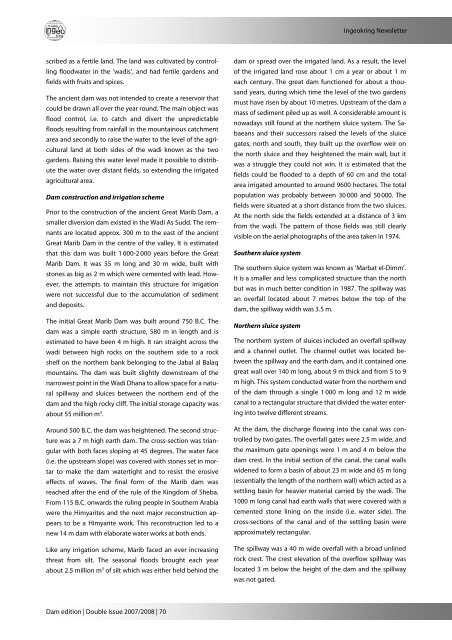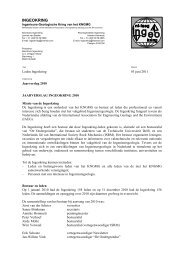News letter Dam edition
News letter Dam edition
News letter Dam edition
- No tags were found...
You also want an ePaper? Increase the reach of your titles
YUMPU automatically turns print PDFs into web optimized ePapers that Google loves.
Ingeokring <strong>News</strong><strong>letter</strong><br />
scribed as a fertile land. The land was cultivated by controlling<br />
floodwater in the ‘wadis’, and had fertile gardens and<br />
fields with fruits and spices.<br />
The ancient dam was not intended to create a reservoir that<br />
could be drawn all over the year round. The main object was<br />
flood control, i.e. to catch and divert the unpredictable<br />
floods resulting from rainfall in the mountainous catchment<br />
area and secondly to raise the water to the level of the agricultural<br />
land at both sides of the wadi known as the two<br />
gardens. Raising this water level made it possible to distribute<br />
the water over distant fields, so extending the irrigated<br />
agricultural area.<br />
<strong>Dam</strong> construction and irrigation scheme<br />
Prior to the construction of the ancient Great Marib <strong>Dam</strong>, a<br />
smaller diversion dam existed in the Wadi As Sudd. The remnants<br />
are located approx. 300 m to the east of the ancient<br />
Great Marib <strong>Dam</strong> in the centre of the valley. It is estimated<br />
that this dam was built 1 000-2 000 years before the Great<br />
Marib <strong>Dam</strong>. It was 55 m long and 30 m wide, built with<br />
stones as big as 2 m which were cemented with lead. However,<br />
the attempts to maintain this structure for irrigation<br />
were not successful due to the accumulation of sediment<br />
and deposits.<br />
The initial Great Marib <strong>Dam</strong> was built around 750 B.C. The<br />
dam was a simple earth structure, 580 m in length and is<br />
estimated to have been 4 m high. It ran straight across the<br />
wadi between high rocks on the southern side to a rock<br />
shelf on the northern bank belonging to the Jabal al Balaq<br />
mountains. The dam was built slightly downstream of the<br />
narrowest point in the Wadi Dhana to allow space for a natural<br />
spillway and sluices between the northern end of the<br />
dam and the high rocky cliff. The initial storage capacity was<br />
about 55 million m 3 .<br />
Around 500 B.C. the dam was heightened. The second structure<br />
was a 7 m high earth dam. The cross-section was triangular<br />
with both faces sloping at 45 degrees. The water face<br />
(i.e. the upstream slope) was covered with stones set in mortar<br />
to make the dam watertight and to resist the erosive<br />
effects of waves. The final form of the Marib dam was<br />
reached after the end of the rule of the Kingdom of Sheba.<br />
From 115 B.C. onwards the ruling people in Southern Arabia<br />
were the Himyarites and the next major reconstruction appears<br />
to be a Himyarite work. This reconstruction led to a<br />
new 14 m dam with elaborate water works at both ends.<br />
Like any irrigation scheme, Marib faced an ever increasing<br />
threat from silt. The seasonal floods brought each year<br />
about 2.5 million m 3 of silt which was either held behind the<br />
dam or spread over the irrigated land. As a result, the level<br />
of the irrigated land rose about 1 cm a year or about 1 m<br />
each century. The great dam functioned for about a thousand<br />
years, during which time the level of the two gardens<br />
must have risen by about 10 metres. Upstream of the dam a<br />
mass of sediment piled up as well. A considerable amount is<br />
nowadays still found at the northern sluice system. The Sabaeans<br />
and their successors raised the levels of the sluice<br />
gates, north and south, they built up the overflow weir on<br />
the north sluice and they heightened the main wall, but it<br />
was a struggle they could not win. It is estimated that the<br />
fields could be flooded to a depth of 60 cm and the total<br />
area irrigated amounted to around 9600 hectares. The total<br />
population was probably between 30 000 and 50 000. The<br />
fields were situated at a short distance from the two sluices.<br />
At the north side the fields extended at a distance of 3 km<br />
from the wadi. The pattern of those fields was still clearly<br />
visible on the aerial photographs of the area taken in 1974.<br />
Southern sluice system<br />
The southern sluice system was known as ‘Marbat el-Dimm’.<br />
It is a smaller and less complicated structure than the north<br />
but was in much better condition in 1987. The spillway was<br />
an overfall located about 7 metres below the top of the<br />
dam, the spillway width was 3.5 m.<br />
Northern sluice system<br />
The northern system of sluices included an overfall spillway<br />
and a channel outlet. The channel outlet was located between<br />
the spillway and the earth dam, and it contained one<br />
great wall over 140 m long, about 9 m thick and from 5 to 9<br />
m high. This system conducted water from the northern end<br />
of the dam through a single 1 000 m long and 12 m wide<br />
canal to a rectangular structure that divided the water entering<br />
into twelve different streams.<br />
At the dam, the discharge flowing into the canal was controlled<br />
by two gates. The overfall gates were 2.5 m wide, and<br />
the maximum gate openings were 1 m and 4 m below the<br />
dam crest. In the initial section of the canal, the canal walls<br />
widened to form a basin of about 23 m wide and 65 m long<br />
(essentially the length of the northern wall) which acted as a<br />
settling basin for heavier material carried by the wadi. The<br />
1000 m long canal had earth walls that were covered with a<br />
cemented stone lining on the inside (i.e. water side). The<br />
cross-sections of the canal and of the settling basin were<br />
approximately rectangular.<br />
The spillway was a 40 m wide overfall with a broad unlined<br />
rock crest. The crest elevation of the overflow spillway was<br />
located 3 m below the height of the dam and the spillway<br />
was not gated.<br />
<strong>Dam</strong> <strong>edition</strong> | Double Issue 2007/2008 | 70




